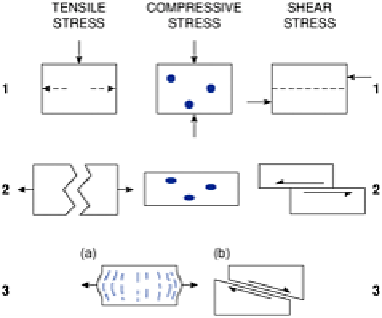Environmental Engineering Reference
In-Depth Information
Figure 13.4
Principal types of stress and failure. Line 1
shows the initial shape of identical blocks prior to failure.
Line 2 shows the failed state; the block subject to compressive
stress has deformed by compression of void space alone. Line
3 shows alternatives: (a) reveals a tensile component short of
rupture, whilst (b) has sheared.
Tensile and compressive stresses are more directly important to tectonic than
geomorphic processes. Together with shear stress, they drive deformation and uplift and
are therefore instrumental in initiating denudation. However, the inherited effect of
deformation in the form of rock structures is of profound geomorphic significance. All
forms of structure - folds, fractures, faults, thrusts, joints, laminations, etc. - regardless of
their lithological or tectonic origin, are
planar discontinuities
which render rock mass
mechanically and hydraulically defective. That is, individually they represent two-
dimensional, planar partings where the homogeneous character of a rock mass, especially
its cohesive or
intact strength
, is momentarily interrupted or lost. There are a number of
key geomorphic consequences. They control the
permeability
of rock, or its capacity to
circulate water and air, which are important weathering agents, and are more important
than
porosity
in that respect. By reducing rock strength, discontinuities make its removal
easier by providing
release surfaces
along which the rock comes apart. They are found at
all scales (Figure 13.5) and those of lithological and tectonic origin form regular, three-
dimensional geometric patterns. This reflects compressive and tensile stress, and
therefore the strain history of the rock, and directs denudation processes accordingly
(Figure 12.20). In addition, faulting juxtaposes rocks of different strengths.
Structural
control
can be seen at every scale from the shape and slope angles of individual
landforms (Plate 13.2), regional patterns of hills, valleys and drainage networks (Figure
13.6), and in continental architecture. All this makes a strong case for a
morphotectonic
approach to geomorphology.
Shear stress is predominant in the operation of geomorphic processes. The balance
between force and resistance - the
limiting equilibrium
- marks the point of

